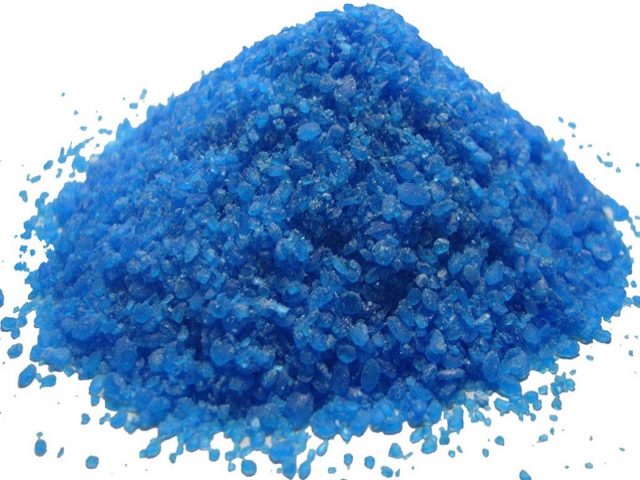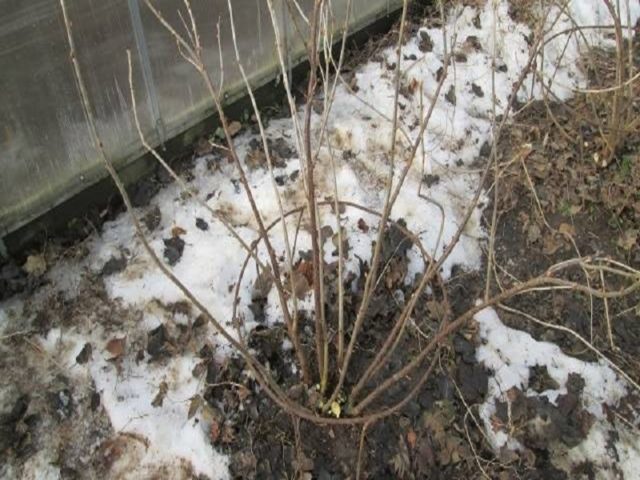Content
Most pests of berry bushes manage to overwinter in the soil and old leaves. Treating currants with copper sulfate at the very beginning of spring will help neutralize insects, prevent their reproduction and prevent the damage they can cause to plants.
An event carried out for preventive purposes guarantees a rich harvest. In spring, it is easier to control pests due to their low activity. It is worth finding out how to prepare a solution of copper sulfate and what are the rules for processing with a chemical agent.
The procedure will require very little time, and the benefits of it are difficult to overestimate.
Is it possible to treat currants with copper sulfate?
The goal of any gardener is to grow healthy berries and fruits. vegetables Copper sulfate or copper sulfate has been used in gardening for a long time. Its effectiveness has been proven in the fight against pathogenic fungi and pests. Despite the fact that the drug has been used for several decades, and during this time new drugs have appeared, it remains in demand today.Copper sulfate not only protects plants, but also has a beneficial effect on the quality of the future harvest.
Treatment of currant bushes with copper sulfate in the spring should be carried out in compliance with the dosage and processing time.
The solution has the property of drying and burning slightly. When exposed to it on young leaves and shoots, in addition to destroying the fungus and its spores, it can cause a burn. It is for this reason that it is advisable to use the drug for preventive purposes before bud break. The procedure is carried out in the spring, when the ambient temperature is not higher than +5 ⁰С. It is used to treat currant branches and plant trunks.
Why do you need to treat currants with copper sulfate?
The appearance of the drug is a powder consisting of blue crystals. Its action is manifested as:
- A fungicide that protects currants from fungal diseases;
- Antiseptic that stops putrefactive processes;
- An insecticide that destroys insects that harm currants;
- Fertilizers that improve soil composition and increase yield.
Copper sulfate is a fungicide intended for treating currants against a number of diseases:
- scab;
- moniliosis;
- anthracnose;
- Alternaria;
- ascochyta;
- rust;
- downy mildew;
- spotting.
The effect of copper sulfate is superficial; the main substance (copper) is not absorbed. After rain or watering, it is washed off, its work stops, but the contact destroys the fungi, and the growth of the mycelium only stops.
Another purpose of copper sulfate is to use it as a fertilizer to replenish copper deficiency in the soil. Experts recommend its use on peat and sandy soils, where microelement deficiency is especially pronounced.The imbalance can be easily eliminated by adding powder (1 g per 1 sq. m) to the soil once a year. Copper sulfate is used as an independent remedy and together with lime as part of a Bordeaux mixture
How to dilute copper sulfate for spraying currants
The lack of results when spraying currants with copper sulfate in the spring is explained by errors in the use and dilution of the drug.
It must be remembered that spring processing is carried out in the “green cone” stage.
When the leaves appear, it is too late to carry out the treatment, since time has been lost and the plant may get burned.
To obtain the solution you need:
- Prepare a glass or enamel container and hot water (about 50⁰C).
- Copper sulfate must be poured into hot water and placed in a water bath to speed up the process.
- Pour the prepared solution into the sprayer tank.
- Bring the concentration to the required values.
- Process the currants.
To process currants, copper sulfate can be diluted in different proportions, depending on the purpose:
- medicinal – 3% (300 g of copper sulfate per 10 liters of water);
- preventive – 0.5% – 1% (50 – 100 g per 10 liters of water).
You should know that as the amount of water increases and the concentration of the solution decreases, its color becomes more saturated - from blue to dark blue.
Treatment is carried out early in the morning or late in the evening, in calm weather. When diluting copper sulfate, the following safety precautions should be observed:
- use rubber gloves;
- carry out work away from children and animals;
- Avoid getting the solution on exposed areas of the body;
- rinse them thoroughly under running water if this happens;
- Only the required amount of solution should be prepared.
How to treat currants with copper sulfate
To disinfect the root system and crown of currants, treatment with copper sulfate is carried out in early spring. The soil under the bushes is sprayed with a preventive solution. First, you should remove all last year's foliage from under the bush and repair damage to the branches with garden varnish.
Bordeaux mixture is prepared using copper sulfate, which also contains lime. Such a solution can harm the larvae and eggs of pests, corroding them.
When preparing the mixture yourself, you should strictly adhere to the proportions, otherwise the currant bushes may be damaged.
For treatment carried out before bud break, you will need a 3% mixture:
- Both components, vitriol and lime, are diluted in different containers (glass or plastic).
- The copper sulfate solution is poured into the lime solution.
- After mixing, the composition is filtered.
The average consumption per currant bush is 1.5 liters of solution. Currants are treated with Bordeaux mixture using one of three types of sprayer:
- mechanical – air is pumped into the tank manually using a hand pump;
- electric – pressure is created automatically by an electric motor;
- petrol engine - work on the basis of an internal combustion engine.
For small areas, mechanical is quite sufficient; large areas of currants require electric and gasoline-powered devices.
When spraying, you must ensure that the soil and parts of plants are covered evenly with the solution.
Pest and disease control is effective if carried out annually and regularly.
Advice from experienced gardeners
When processing currants, gardeners recommend following certain rules:
- since copper sulfate is an acidic salt, you should monitor the pH of the soil and reduce the acidity if necessary;
- Copper sulfate is a chemical, so when working with it you should use gloves, boots, goggles, and a respirator;
- Spraying should not be carried out in early autumn;
- the beneficial properties of the drug are reduced if, after treatment, the currants are exposed to rain;
- you need to constantly monitor the plants so as not to miss the moment of need for spraying.
Conclusion
Treatment of currants with copper sulfate is considered a productive means in the fight against pests and fungal diseases. It is necessary to accurately determine the time and need for spraying, and apply the required concentration of the solution so as not to cause additional harm to the plants.
Caring for berry bushes should be comprehensive: timely and regular pruning, fertilizing and treatment with folk remedies and chemicals ensures the health of the currants and a rich harvest of berries.













